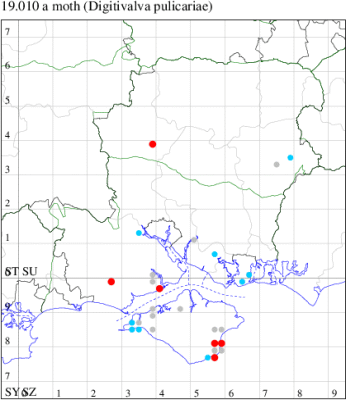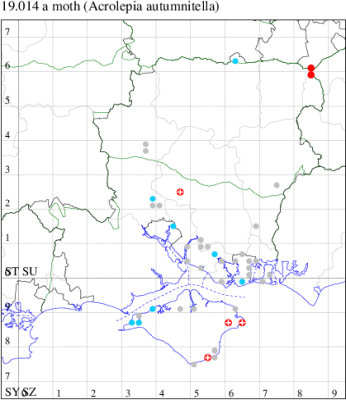2022 Annual Report for: Glyphipterigidae / Acrolepiinae
For species seen in 2022 that had less than or equal to 100 records, full details are included; for more common species, the earliest, latest and highest count by vice-county are shown. The narrative for each species is taken from the main Hantsmoths website, and it is possible that some information on abundance and occurrence can get out of date, as it is impossible to keep up with all changes; however it should give a good introduction to each species. The tables in each species account summarise the previous status, and that for the current year.
For the maps, all records prior to 2022 are shown by a blue dot (the larger the dot, the more recent), with the current year's records shown in red. As previous records are superimposed on any report for 2022, new sites have greater emphasis (i.e. will show as 'more red').
In the species accounts, an asterisk next to a location indicates a new 10km square record; earliest ever dates are highlighted in orange, and latest ever in red. Initials in the species accounts refer to the recorders listed here. Please get in touch if you identify any omissions or errors, in particular if you have records that have yet to be submitted. Details of how to submit records can be found here.
19.010 [B&F: 0472] Digitivalva pulicariae (Klimesch, 1956) - Local
Local in rough meadows, woodland rides and waste ground in England, as far north as Northumberland, Wales and the southern half of Ireland, where it is often common in the south-west. In Hampshire and on the Isle of Wight the few recent records are chiefly from the coast, except for singletons to light in Selborne, Basingstoke and the Deadwater Valley. Wingspan 12-14 mm. Larva mines leaves of Common Fleabane and Hemp-agrimony.
Records prior to 2022
| Vice County | #Records | #Individuals | First Record | Last Record |
|---|---|---|---|---|
| 10 | 178 | 277 | 1856 | 2021 |
| 11 | 75 | 69 | 1989 | 2021 |
| 12 | 6 | 6 | 1996 | 2021 |
2022 records
| Vice County | #Records | #Individuals | Max Quantity |
|---|---|---|---|
| 10 | 9 | 24 | 8 |
| 11 | 2 | 2 | 1 |
| 12 | 1 | 1 | 1 |

Records by year
Records by week (adult)
Records by week (larval)
Record Details
VC10: Wheelers Bay, one, 09 Aug (ABut); Shanklin, two, 06 Jul; eight, 08 Jul; two, 09 Jul; six, 11 Jul; one, 12 Jul; one, 20 Jul; two, 28 Jul; Shanklin Upper Chine, one, 04 Aug (IOu);
VC11: Sway*, one, 18 Jul (SKee); Needs Ore NNR, three, 21 Jul; one, 25 Jul (CNB);
VC12: Chilbolton*, one, 07 Aug (GCE)
19.014 [B&F: 0476] Acrolepia autumnitella Curtis, 1838 - Common
Common in hedgerows and waste ground throughout much of southern England, with records north to Lancashire. In Hampshire and on the Isle of Wight reasonably common especially in the south-east of the county and on the Island. Wingspan 11-13 mm. Larva mines leaves of Woody Nightshade and Deadly Nightshade.
Records prior to 2022
| Vice County | #Records | #Individuals | First Record | Last Record |
|---|---|---|---|---|
| 10 | 101 | 52 | 1900 | 2021 |
| 11 | 137 | 142 | 1978 | 2021 |
| 12 | 20 | 13 | 1981 | 2016 |
2022 records
| Vice County | #Records | #Individuals | Max Quantity |
|---|---|---|---|
| 10 | 3 | 2 | 2 |
| 11 | 1 | 5 | 5 |
| 12 | 3 | 3 | 1 |

Records by year
Records by week (adult)
Records by week (larval)
Record Details
VC10: Ventnor, mine, present, many mines, some with larvae, on leaves of Solanum laciniatum. No frass in whitish mine. Adult reared emerging early November 2022, 27 Sep; Brading, mine, two, mines, with larvae, on Solanum dulcamara. Whitish blotch mine with no frass, 22 Sep; Foreland, mine, present, several mines on leaves of what is probably Solanum laciniatum. Mines white with no frass, 20 Sep (PBar);
VC11: Twyford, vacated mine, five, 5+ vacated mines on Solanum dulcamara. Berry Meadow, 11 Jul (RJD);
VC12: Blackwater, one, field observation, 21 Mar; one, 13 Jul; one, field observation, 07 Aug (BGD)